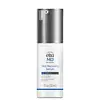What's inside
What's inside
 Key Ingredients
Key Ingredients

 Benefits
Benefits

 Concerns
Concerns

 Ingredients Side-by-side
Ingredients Side-by-side

Water
Skin ConditioningPropanediol
SolventIsododecane
EmollientGlycerin
HumectantDimethicone
EmollientPolymethylsilsesquioxane
Polysilicone-11
Panthenol
Skin ConditioningCoco-Caprylate/Caprate
EmollientTaurine
BufferingSodium Acrylate/Sodium Acryloyldimethyl Taurate Copolymer
Emulsion StabilisingArginine
MaskingButylene Glycol
HumectantTocopherol
AntioxidantHydroxyacetophenone
AntioxidantIsohexadecane
EmollientCentella Asiatica Leaf Extract
Skin ConditioningAmmonium Acryloyldimethyltaurate/Carboxyethyl Acrylate Crosspolymer
Caprylyl Glycol
Emollient1,2-Hexanediol
Skin ConditioningCoco-Glucoside
CleansingPolysorbate 80
EmulsifyingDecyl Glucoside
CleansingHydroxyethylcellulose
Emulsion StabilisingCitric Acid
BufferingTrisodium Ethylenediamine Disuccinate
Glycine
BufferingSodium Hyaluronate
HumectantWater, Propanediol, Isododecane, Glycerin, Dimethicone, Polymethylsilsesquioxane, Polysilicone-11, Panthenol, Coco-Caprylate/Caprate, Taurine, Sodium Acrylate/Sodium Acryloyldimethyl Taurate Copolymer, Arginine, Butylene Glycol, Tocopherol, Hydroxyacetophenone, Isohexadecane, Centella Asiatica Leaf Extract, Ammonium Acryloyldimethyltaurate/Carboxyethyl Acrylate Crosspolymer, Caprylyl Glycol, 1,2-Hexanediol, Coco-Glucoside, Polysorbate 80, Decyl Glucoside, Hydroxyethylcellulose, Citric Acid, Trisodium Ethylenediamine Disuccinate, Glycine, Sodium Hyaluronate
Water
Skin ConditioningIsononyl Isononanoate
EmollientPropanediol
SolventAmmonium Acryloyldimethyltaurate/Vp Copolymer
Polyacrylamide
Phenoxyethanol
PreservativeTaurine
BufferingC13-14 Isoparaffin
EmollientArginine
MaskingSaccharide Isomerate
HumectantCitric Acid
BufferingTocopheryl Acetate
AntioxidantLaureth-7
EmulsifyingTocopherol
AntioxidantBisabolol
MaskingLespedeza Capitata Leaf/Stem Extract
Skin ConditioningEthylhexylglycerin
Skin ConditioningSodium Phytate
Pentaerythrityl Tetra-Di-T-Butyl Hydroxyhydrocinnamate
AntioxidantMelia Azadirachta Leaf Extract
Skin ConditioningMelia Azadirachta Flower Extract
Skin ConditioningGlycine
BufferingCorallina Officinalis Extract
Skin ConditioningCoccinia Indica Fruit Extract
Skin ConditioningSolanum Melongena Fruit Extract
Skin ConditioningAloe Barbadensis Flower Extract
EmollientSodium Hyaluronate
HumectantSimmondsia Chinensis Seed Oil
EmollientZingiber Officinale Root Extract
MaskingOcimum Sanctum Leaf Extract
Skin ConditioningOcimum Basilicum Flower/Leaf Extract
TonicCurcuma Longa Root Extract
MaskingWater, Isononyl Isononanoate, Propanediol, Ammonium Acryloyldimethyltaurate/Vp Copolymer, Polyacrylamide, Phenoxyethanol, Taurine, C13-14 Isoparaffin, Arginine, Saccharide Isomerate, Citric Acid, Tocopheryl Acetate, Laureth-7, Tocopherol, Bisabolol, Lespedeza Capitata Leaf/Stem Extract, Ethylhexylglycerin, Sodium Phytate, Pentaerythrityl Tetra-Di-T-Butyl Hydroxyhydrocinnamate, Melia Azadirachta Leaf Extract, Melia Azadirachta Flower Extract, Glycine, Corallina Officinalis Extract, Coccinia Indica Fruit Extract, Solanum Melongena Fruit Extract, Aloe Barbadensis Flower Extract, Sodium Hyaluronate, Simmondsia Chinensis Seed Oil, Zingiber Officinale Root Extract, Ocimum Sanctum Leaf Extract, Ocimum Basilicum Flower/Leaf Extract, Curcuma Longa Root Extract
Ingredients Explained
These ingredients are found in both products.
Ingredients higher up in an ingredient list are typically present in a larger amount.
Arginine is an amino acid that is important for human development. Your body uses is it to produce hair keratin and skin collagen.
As a cosmetic ingredient, Arginine has antioxidant properties and can also help repair damaged skin. This ingredient is derived either synthetically or from animals.
Arginine isn't fungal acne safe when used in the presence of other lipids (fats, fatty acids, oils, esters, etc). Oils and fats occur naturally within the skin, so take caution when using Arginine if you're prone to fungal acne.
Learn more about ArginineCitric Acid is an alpha hydroxy acid (AHA) naturally found in citrus fruits like oranges, lemons, and limes.
Like other AHAs, citric acid can exfoliate skin by breaking down the bonds that hold dead skin cells together. This helps reveal smoother and brighter skin underneath.
However, this exfoliating effect only happens at high concentrations (20%) which can be hard to find in cosmetic products.
Due to this, citric acid is usually included in small amounts as a pH adjuster. This helps keep products slightly more acidic and compatible with skin's natural pH.
In skincare formulas, citric acid can:
While it can provide some skin benefits, research shows lactic acid and glycolic acid are generally more effective and less irritating exfoliants.
Most citric acid used in skincare today is made by fermenting sugars (usually from molasses). This synthetic version is identical to the natural citrus form but easier to stabilize and use in formulations.
Read more about some other popular AHA's here:
Learn more about Citric AcidThis ingredient is an amino acid that helps build proteins and moisturizes skin. It is already present in our skin as our bodies produce them naturally.
Glycine already plays a role in helping keep our skin moisturized as amino acids transport moisture throughout our skin.
As collagen is made up of glycine and other amino acids, it is believed glycine may help our skin produce more collagen.
Learn more about GlycinePropanediol is an all-star ingredient. It softens, hydrates, and smooths the skin.
It’s often used to:
Propanediol is not likely to cause sensitivity and considered safe to use. It is derived from corn or petroleum with a clear color and no scent.
Learn more about PropanediolSodium Hyaluronate is hyaluronic acid's salt form. It is commonly derived from the sodium salt of hyaluronic acid.
Like hyaluronic acid, it is great at holding water and acts as a humectant. This makes it a great skin hydrating ingredient.
Sodium Hyaluronate is naturally occurring in our bodies and is mostly found in eye fluid and joints.
These are some other common types of Hyaluronic Acid:
Learn more about Sodium HyaluronateWe don't have a description for Taurine yet.
Tocopherol (also known as Vitamin E) is a common antioxidant used to help protect the skin from free-radicals and strengthen the skin barrier. It's also fat soluble - this means our skin is great at absorbing it.
Vitamin E also helps keep your natural skin lipids healthy. Your lipid skin barrier naturally consists of lipids, ceramides, and fatty acids. Vitamin E offers extra protection for your skin’s lipid barrier, keeping your skin healthy and nourished.
Another benefit is a bit of UV protection. Vitamin E helps reduce the damage caused by UVB rays. (It should not replace your sunscreen). Combining it with Vitamin C can decrease sunburned cells and hyperpigmentation after UV exposure.
You might have noticed Vitamin E + C often paired together. This is because it is great at stabilizing Vitamin C. Using the two together helps increase the effectiveness of both ingredients.
There are often claims that Vitamin E can reduce/prevent scarring, but these claims haven't been confirmed by scientific research.
Learn more about TocopherolWater. It's the most common cosmetic ingredient of all. You'll usually see it at the top of ingredient lists, meaning that it makes up the largest part of the product.
So why is it so popular? Water most often acts as a solvent - this means that it helps dissolve other ingredients into the formulation.
You'll also recognize water as that liquid we all need to stay alive. If you see this, drink a glass of water. Stay hydrated!
Learn more about Water